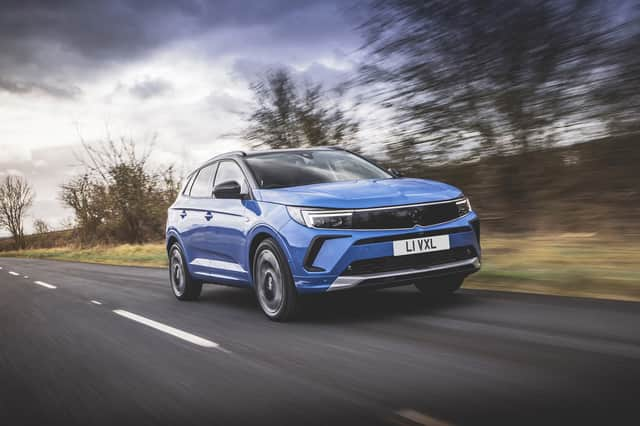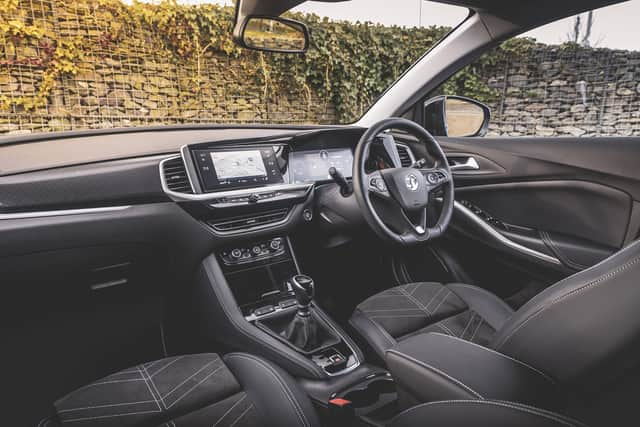MOTORS REVIEW: Vauxhall Grandland Ultimate


This summer the new Astra reaches dealerships in what should form the final piece of the puzzle to separate the British brand from an unprofitable past under General Motors.
But the last of its SUVs to gain the brand’s new “Vizor” front end treatment has perhaps undergone the mildest transformation.
Advertisement
Hide AdAdvertisement
Hide AdHaving been created in partnership with French carmaker PSA (now half of Stellantis), the Grandland could be considered as part of the roots of Vauxhall’s eventual path to new ownership.
Sharing a platform with the Peugeot 3008 and 5008 it was always that bit more stylish and better resolved and so its 2022 makeover feels fairly mild by comparison to the huge strides taken by the latest Mokka.
At launch, Grandland prices start at £25,810 for the 130PS 1.2-litre petrol powered Design, with a 130PS 1.5 diesel and 225PS plug-in hybrid (PHEV) also available across a range also featuring GS Line (from £28,070) and Ultimate (from £31,370) grades.
The range-topping Grandland Ultimate HYBRID-e PHEV costs £37,375, claiming a zero-emissions range of up to 39 miles and 31g/km CO2 emissions which will likely appeal to business users considering BIK tax implications.
Advertisement
Hide AdAdvertisement
Hide AdVauxhall will be a purely electric brand by 2028, so time is running out for such a breadth of drivetrains.
We got behind the wheel of the £32,270 Grandland Ultimate 1.2 petrol.
Those doubting the presence of a 1.2-litre petrol engine in a mid-sized SUV should give the multi award-winning Stellantis unit a try.
Fitted in models across the Citroen, DS, Peugeot and Vauxhall portfolio, the three-cylinder unit mates well with the six-speed manual gearbox tested here to deliver a surprisingly flexible spread of power.
Advertisement
Hide AdAdvertisement
Hide AdVauxhall’s 10.4 second acceleration to 62mph claim might not set the world alight, but the Grandland never felt slow or over-worked as it delivered on claims of 44.8 to 45.6mpg fuel economy and 139 to 141g/km CO2 emissions.
In dynamic terms, the Vauxhall is less firm and accurate than a Peugeot 3008, but well short of the soft — sometimes soggy — ride of a Citroen C5.
And, while it will compete with the likes of the Kia Sportage and Skoda Karoq, it is almost worth considering the Grandland as it compares to its Stellantis stablemates.
In size terms there is little to pick between the Grandland and similarly-priced 3008, the Grandland being 3cm longer but falling six litres short on boot space, with its still sizeable 514-litre space.
Advertisement
Hide AdAdvertisement
Hide AdInside, those not keen on the low-oriented tiny steering wheel and high instrument cluster of the Peugeot’s i-Cockpit cabin will likely prefer the conventional set-up of the Grandland.
In Ultimate spec, Vauxhall mates a ten-inch touchscreen infotainment system with a 12-inch instrument cluster.


Elsewhere, it goes without the Peugeot’s stylish toggle switches and dramatic tiered dashboard in favour of a more instantly familiar feel.
There is black gloss trim adding some glitter to the centre console, but there is plenty of grey plastic in less prominent areas.
Advertisement
Hide AdAdvertisement
Hide AdThe Grandland’s cabin is accommodating, familiar and functional, stylish even, but in a more subtle way than a Peugeot or slightly retro and quirky Citroen.
There is all the technology you would hope for, though. Along with those dominant screens — serving-up sat-nav, a 360-degree parking camera and Apple CarPlay or Android Auto phone connectivity — there is keyless entry and starting, adaptive cruise control and lane keeping assistance.
There is also a heated windscreen, a flat-bottomed heated steering wheel, heated leather/Alcantara seats and a wireless smartphone charging plate.
Night vision with pedestrian detection and new adaptive IntelliLux LED Pixel Light headlights are also options.
Advertisement
Hide AdAdvertisement
Hide AdWhile the Grandland GS Line features a contrasting black roof, outside Ultimate trim is defined by an upgrade from 18-inch to 19-inch alloys and low-effect front and rear skid plates.
The previous Grandland X was fairly handsome but understated. Now it’s actually fairly striking, in no small part thanks to the new Cobalt Blue colour seen here.
The 2022 launch of the new Grandland might not have felt like the revolutionary step taken by the Mokka and Astra in their latest iterations, but that is because it has been the best of the brand’s crop for some time.
Now it simply aligns more closely to a Vauxhall range which looks more appealing than is has done in (my) living memory and ensures that the brand has a platform to take on its market rivals in the UK’s most popular market segment.